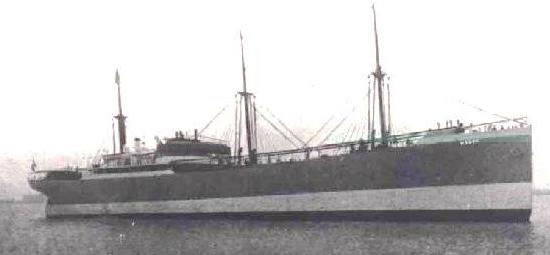KAKYAKUSEN
 (TORNATOR GO former SELANDIA in 1912)
(TORNATOR GO former SELANDIA in 1912)
Transport TORNATOR GO:
Tabular Record of Movement
© 2010-2011 Bob Hackett and Peter Cundall.
E 1911:
Copenhagen, Denmark. Laid down at Burmeister & Wain, Ltd. shipyard as a 4,964 ton passenger-cargo ship for the East Asiatic Co. (EAC) of Denmark.
E 1911:
Launched and named SELANDIA.
17 February 1912:
Completed as the world’s first commercially operated ocean-going motor (diesel) ship.
23 February 1912:
Loads cement at Norre Sundby, Denmark for Bangkok. Crown Prince Axel of the Danish Royal Family boards the ship and travels as far as Elsinore. Later, SELANDIA sails to London where she is visited by hundreds of shipping industry representatives and members of the public including Winston Churchill.
26 June 1912:
Arrives at Copenhagen after return from Bangkok.
August 1914: WWI Begins:
SELANDIA is in Bangkok at the outbreak of war in Europe. Because of her value, she remains trading in the Far East and does not return to Europe until war's end.
1919:
Arrives back in Denmark where she is refitted for the East Asiatic Co's Bangkok route. A typical round voyage now takes 4-5 months including visits to 20-25 ports.
1931:
Put at the disposal of the King of Siam for a voyage from Bangkok to Hong Kong and return.
1932:
Modernised in a Danish shipyard. Passenger accommodation is increased. SELANDIA can now carry 40 passengers compared to 26 previously. Placed in service between San Francisco, the Canadian West Coast and the Far East.
10 November 1936:
Arrives at Copenhagen at end of her last voyage for EAC.
November 1936:
Sold to the Norwegian firm A/S Norseman (Odd Godager) company. Registered in Panama, reflagged and renamed NORSEMAN.
November 1938:
Departs Novorossiysk, Russia for Oslo, Norway with a cargo of grain. While transiting the Mediterranean Sea, NORSEMAN is stopped by Spanish Nationalist warships. After a long delay, she is allowed to proceed, but while crossing the Bay of Biscay in bad weather, she suffers leaks.
Puts into Brest, France. Undergoes hull repairs. Upon completion, departs for Oslo.
1938:
Oslo, Norway. A fire breaks out in one of NORSEMAN’s holds and causes considerable damage. Undergoes repairs. At the same time, the number of her passenger berths is reduced. Later, she is laid up because no work is available.
1939:
Sold to Norseman Steamship Co. Inc., Panama (Bulk Carriers Corp, New York). [1]
30 November 1939: The Winter War:
The Soviet Union invades Finland.
13 March 1940: The Moscow Peace Treaty:
Hostilities cease. Finland cedes to the Soviet Union their entire Karelian Isthmus as well as a large swath of land
north of Lake Ladoga and a part of the Salla region and other parts - in all 11 percent of its pre-war territory and 30 percent of its economic assets.
9 April 1940: Operation Weser-Exercise (Unternehmen Weserübung):
Germany invades Norway and Denmark.
October 1940:
NORSEMAN is sold to Finland-Amerika Linjen and renamed TORNATOR. [2]
7 March 1941:
Departs Liinahamari, Finland (now Russia) via the Panama Canal for Yokohama and Kobe carrying a cargo of Swedish steel and Finnish paper.
27 May 1941:
Arrives at Yokohama.
25 June 1941: The Continuation War:
The Soviet Union launches a massive air raid against Finnish cities. Finland declares war on the Soviet Union and allows German troops stationed in Finland to begin offensive warfare, thus becoming an Axis ally.
June 1941:
Yokohama. TORNATOR loads a cargo of tobacco and fiber for her return voyage, but before her departure, her master and crew learn Finland is again at war on the Axis side.
1941:
Chartered to Yamashita Kisen (Steamship Co.) K.K. of Tokyo. The Finnish crew stays on board. Referred to in all official Japanese records as TORNATOR GO. Assigned to the Japan-Darien, Manchuria line.
26 January 1942:
Departs an unknown Chinese port for Japan with a cargo of salt, but is stranded at Omaisaki (between Nagoya and Yokohama).
30 January 1942:
TORNATOR GO breaks in two and becomes a total loss.
1942:
After the ship is lost, the Finnish crew stays in Yokohama. [3]
Authors' Note:
[1] One Finnish researcher thinks the Norwegians sold the ship to Finland to prevent its capture by the Germans.
[2] It is unclear whether the Finnish-America line bought the ship directly from the Panamanian/Norwegian company, or if the Germans were involved.
[3] One source says that a few of the crew returned to Germany aboard an unknown U-boat; this seems doubtful, but if it did occur, it was not in 1942. Other sources say the rest of the crew boarded a German blockade runner. Possibly, this may have been the 7,983 ton German cargo ship RAMSES that departed Yokohama for Batavia (now Jakarta), via Kobe and Balikpapen, Borneo on 10 Oct ‘42. Reportedly, ten Finnish seamen were aboard. On 23 Nov ’42, RAMSES departed Batavia with a cargo of rubber for Bordeaux, France, but on 28 Nov ‘42, she was intercepted in the Indian Ocean by Australian light cruiser HMAS ADELAIDE accompanied by Dutch light cruiser JACOB VAN HEEMSKIRK. The Germans scuttled the ship. Survivors were interned in Australia.
Thanks go to Mrs. Siri Lawson and the guys on her Warsailors.com message board.
Bob Hackett and Peter Cundall.
Back to
Ex-Axis Merchants in Japanese Service





